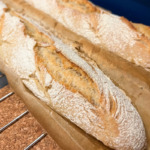
This is Paul's baguette recipe! My husband perfected this bread recipe over time and the result is always a crusty and airy french style baguette.
The recipe is great for bread baking beginners (Paul is also a beginner bread baker). No kneading by hand, but you need a hand or stand mixer.
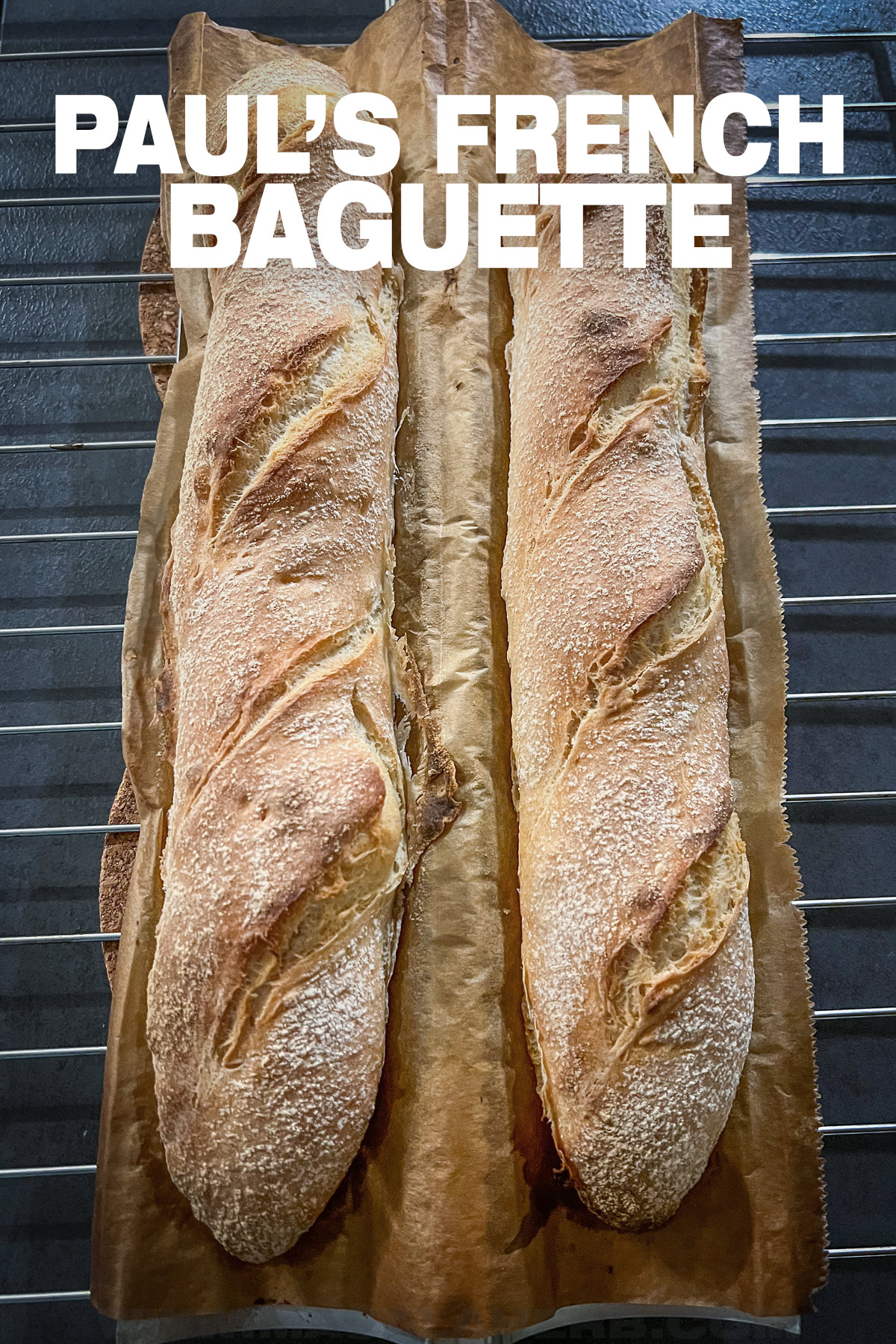

Global Food Recipes
with Spices and Herbs
Free E-Book available for a limited time. Grab yours now and get instantly inspired!
You missed out!
Jump to:
This is a baguette bread recipe prepared with simple ingredients.
Besides, you don't need fancy bread baking equipment such as a proofing couche or a baking stone because this bread recipe is a super simple, almost fool-proof version made for bread baking beginners.
You also don't need plastic wrap. 🙂
📕 What is Baguette?
The baguette is a French elongated white bread with a crunchy crust and an airy light bread texture on the inside.
Today if you go to a bakery in France, the regular most common baguette will be about 24 to 26 inches (60 to 65 cm) long.
This wasn't always the case because after the war the baguettes got to a whooping 39 inches (ca. 1 m).
Classic sized French baguette are also called Baguette de Paris or flûte, but this is just one variety of three. They are differentiated by weight and length.
The other two are the ficelle (a thinner and lighter baguette), and the shorter demi-baguette.
Paul's recipe is a demi-baguette because that's the one that fits into your home oven.
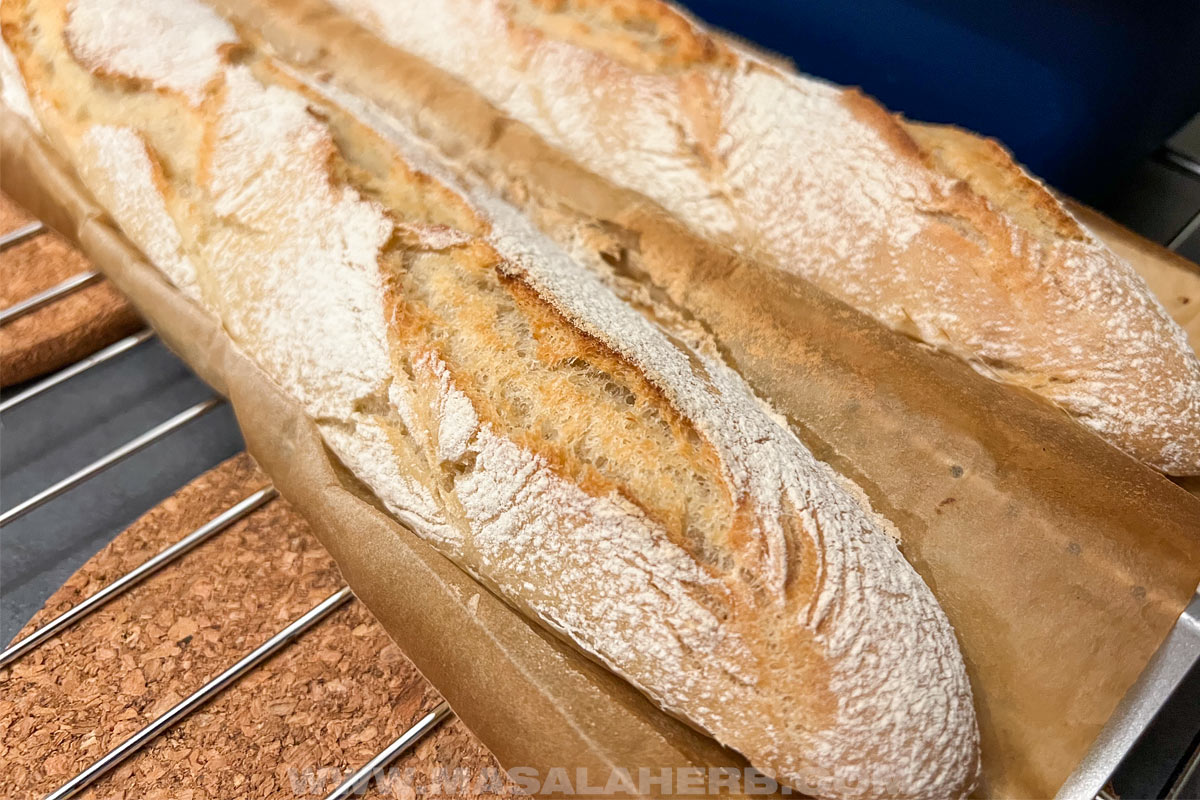
🥖 Ingredients
Here is an overview of what you need (full recipe card further below):
- Flour
- Table Salt
- Yeast
- Sugar
- Water
- Olive Oil
For the flour Paul recommends light and fine pastry flour. It's also sold as Italian 00 flour or double 00 flour in the US and UK.
If you have only regular all-purpose-flour at home, you can use that too. At first, Paul used all-purpose flour, but he learned that the baguette would turn out lighter and more perfect with the pastry flour.
For the yeast, you can use regular dry active yeast or cake compressed yeast.
If you can get fresh cake compressed yeast, use that because it just makes a lot of flavor difference and that's what they use in France.
Fresh cake compressed yeast comes in a cube, and they sell it near the milk in the cooling section in your grocery store. Look out for small yellow cubes of Fleischmann's fresh active yeast or for the bulk Red Star option.
Consider that the quality of your yeast will make or break your bread. Furthermore, make sure to use yeast that is not past the use date.
The sugar can be plain regular sugar. Sugar is needed because the yeast needs to feed through the sugars and adding that to the flour, which is also a carb, gets the yeast to work harder. The result is a fluffier dough!
Your water should be lukewarm because it will create the right comfy environment for your yeast to thrive in. It's all about feeding the yeast in your baguette!
Olive oil adds elasticity to the gluten in your flour so that the dough will be stretchier. It also adds flavor. I recommend an extra virgin olive oil to add quality.
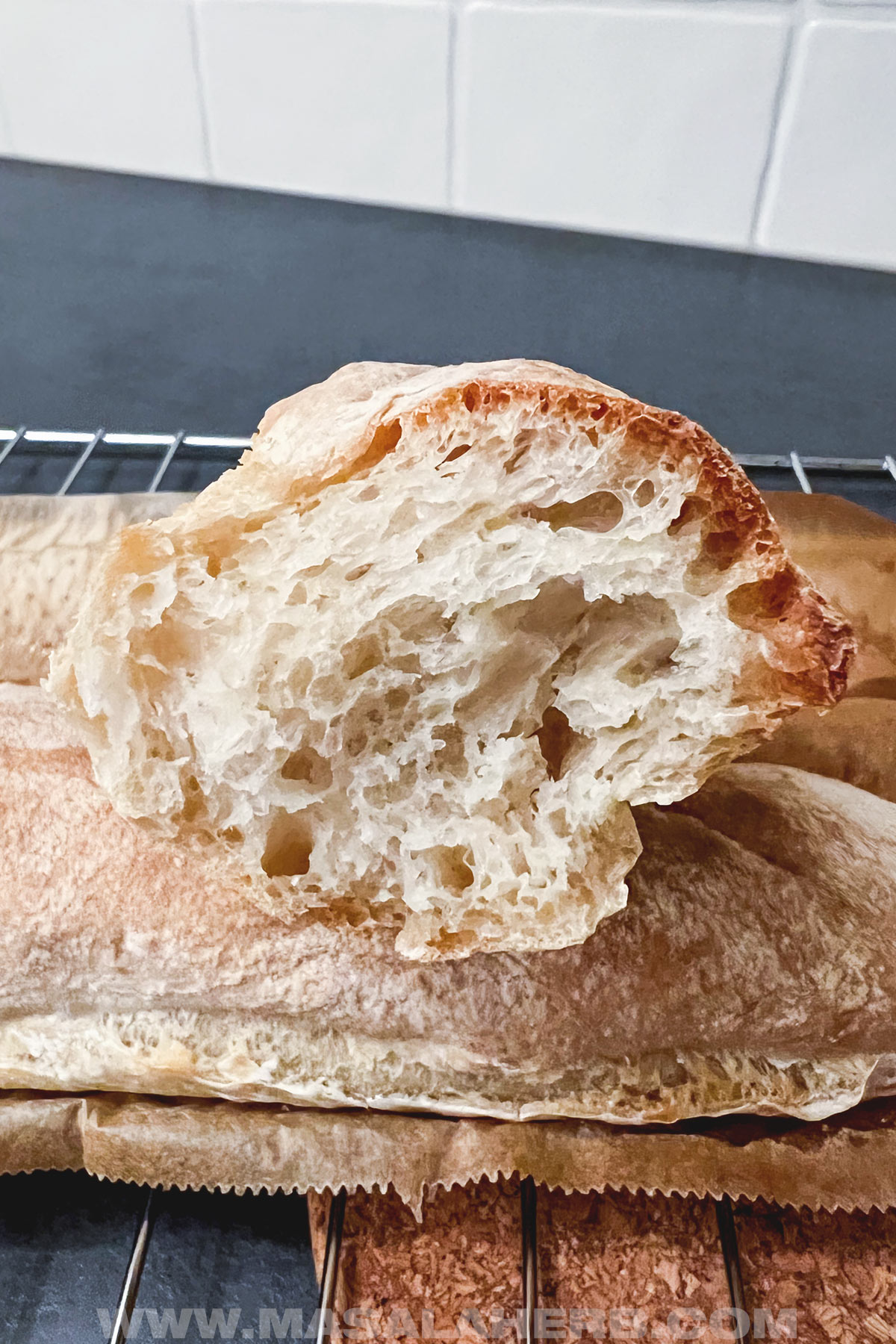
🔪 How to make Paul's Baguette?
This recipe is different from other traditional baguette recipes due to the bread dough consistency.
When I helped Paul develop a working baguette recipe, we faced an issue with dry heavy breads as a result.
After many trials and errors, Paul came to the conclusion that a wet sticky dough would be the solution to an airy light perfect baguette.
It was a success recipe which he ended up perfecting every time he would bake a fresh baguette.
Here is the outline of Paul's Baguette Recipe.
You will find the detailed US and metric measurements further below in the recipe card with the exact instructions and how to video.
Step 1
Stir and dissolve the yeast into water.
Place flour, salt, sugar, olive oil into a large bowl. Pour in the dissolved yeast in the water.
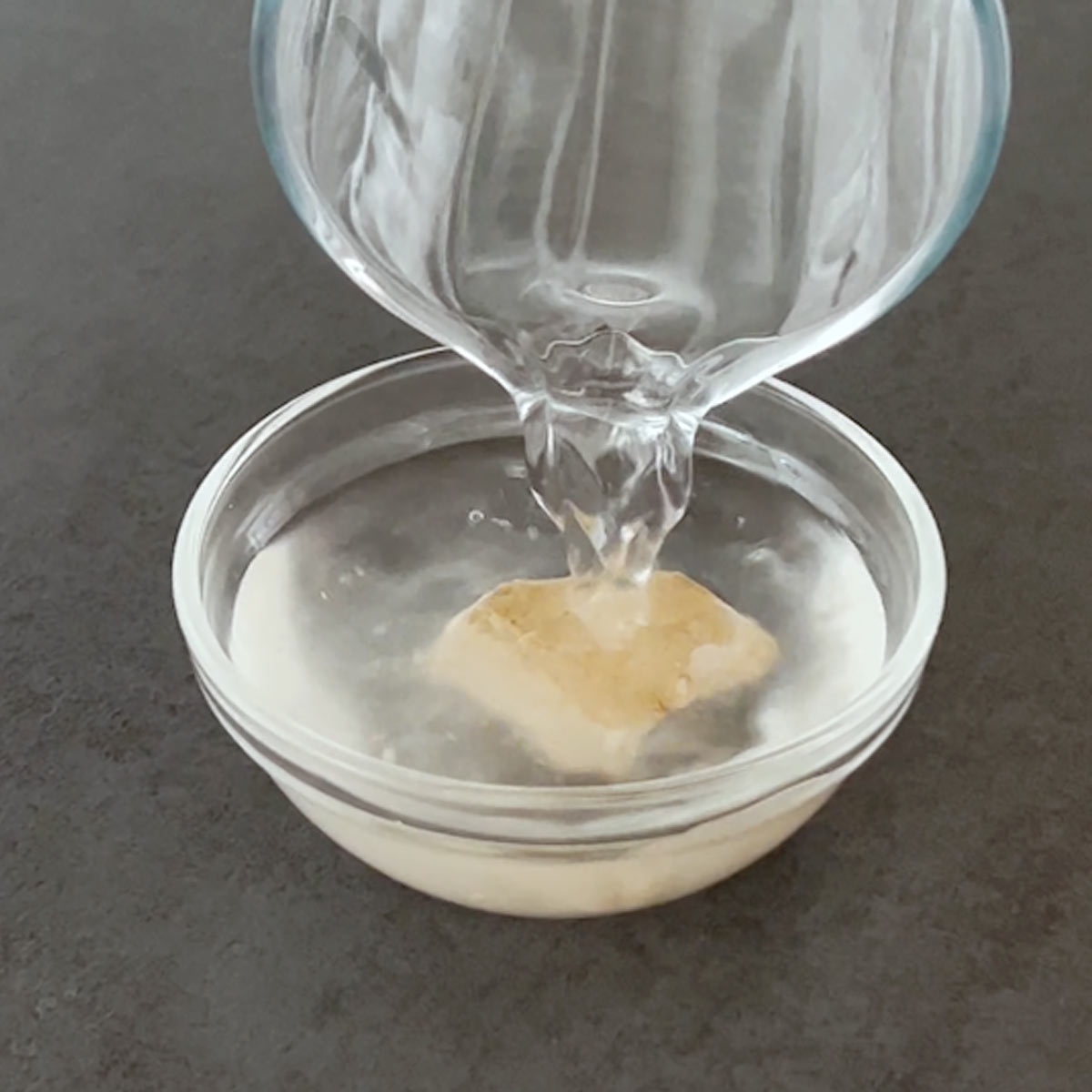
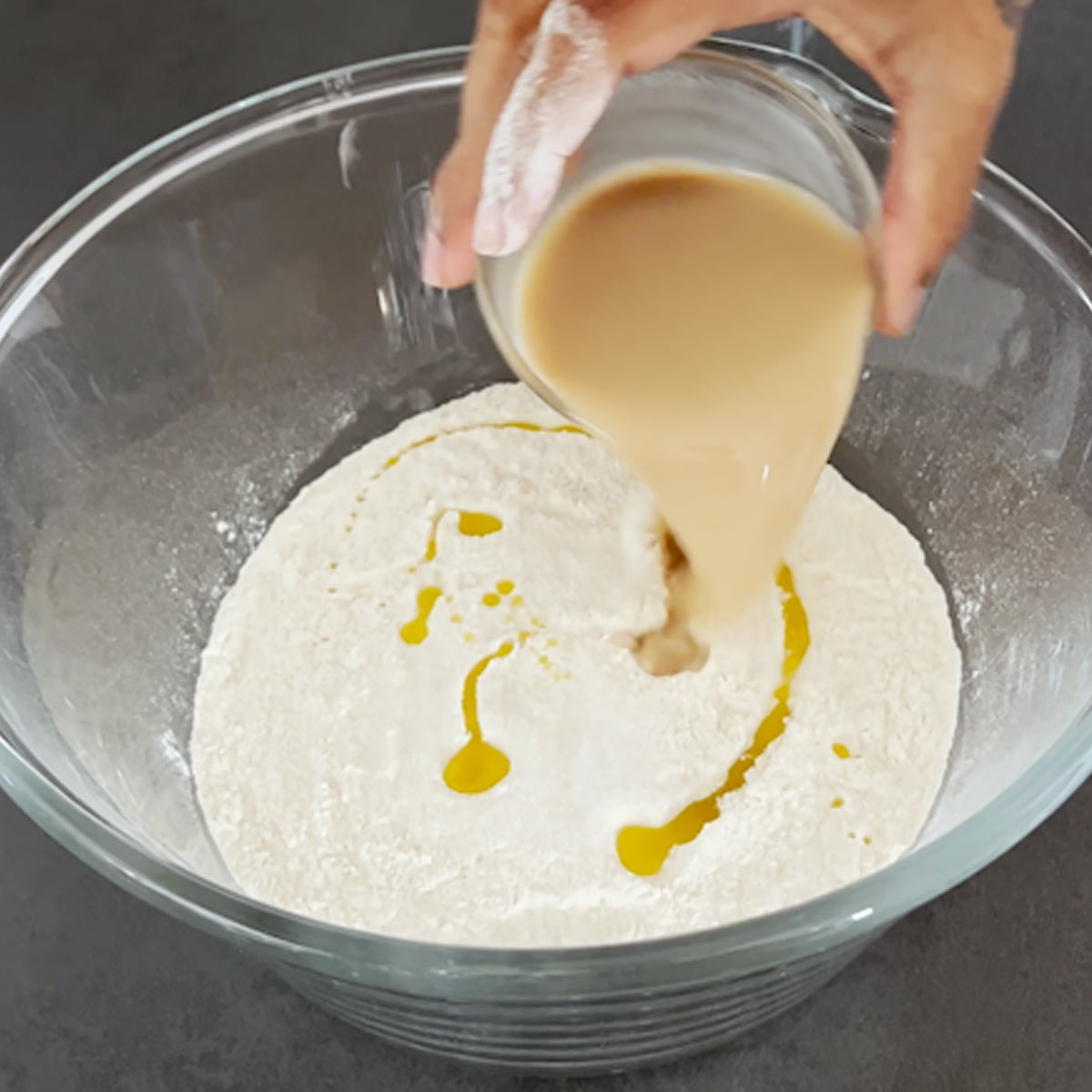
Step 2
Place stand or hand mixer hook into the flour and pour in water.
Mix and knead everything to a smooth thin dough (it's more like a batter). This can take 5 minutes.
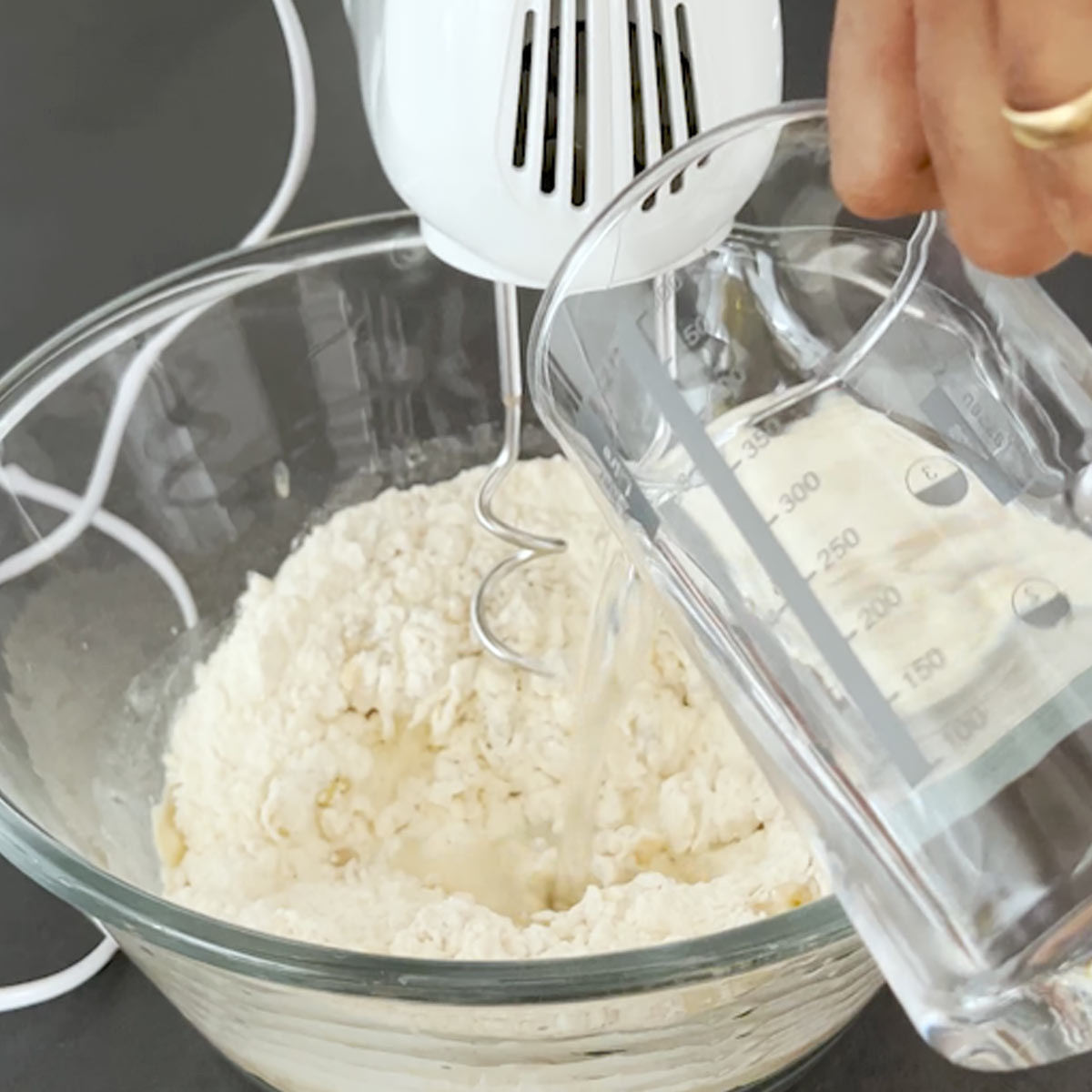
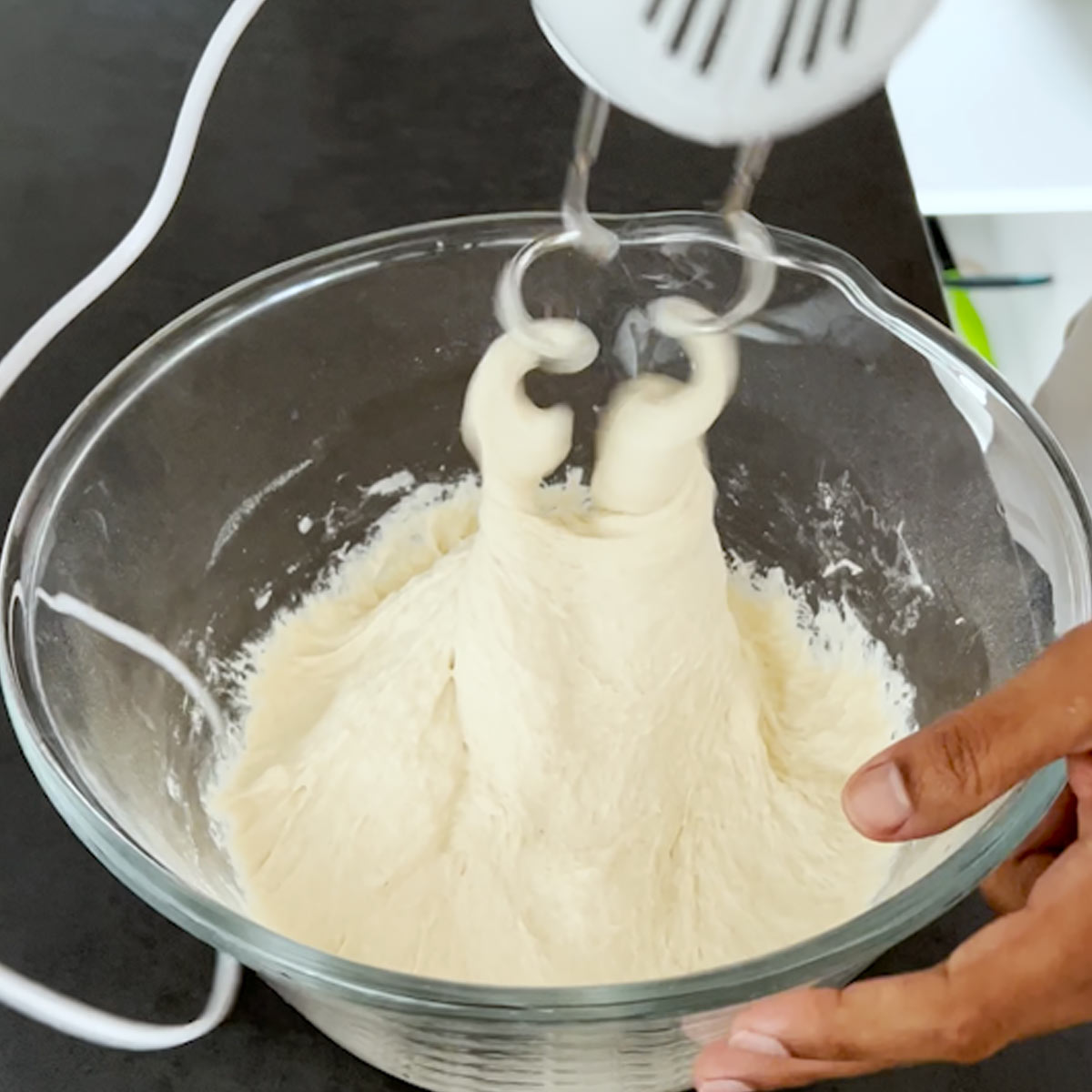
Step 3
Scrape batter off the sides and place the thin dough into the center of your bowl.
Cover your bowl with a damp kitchen towel.
Leave the dough to rest at room temperature for 2 ½ hours.
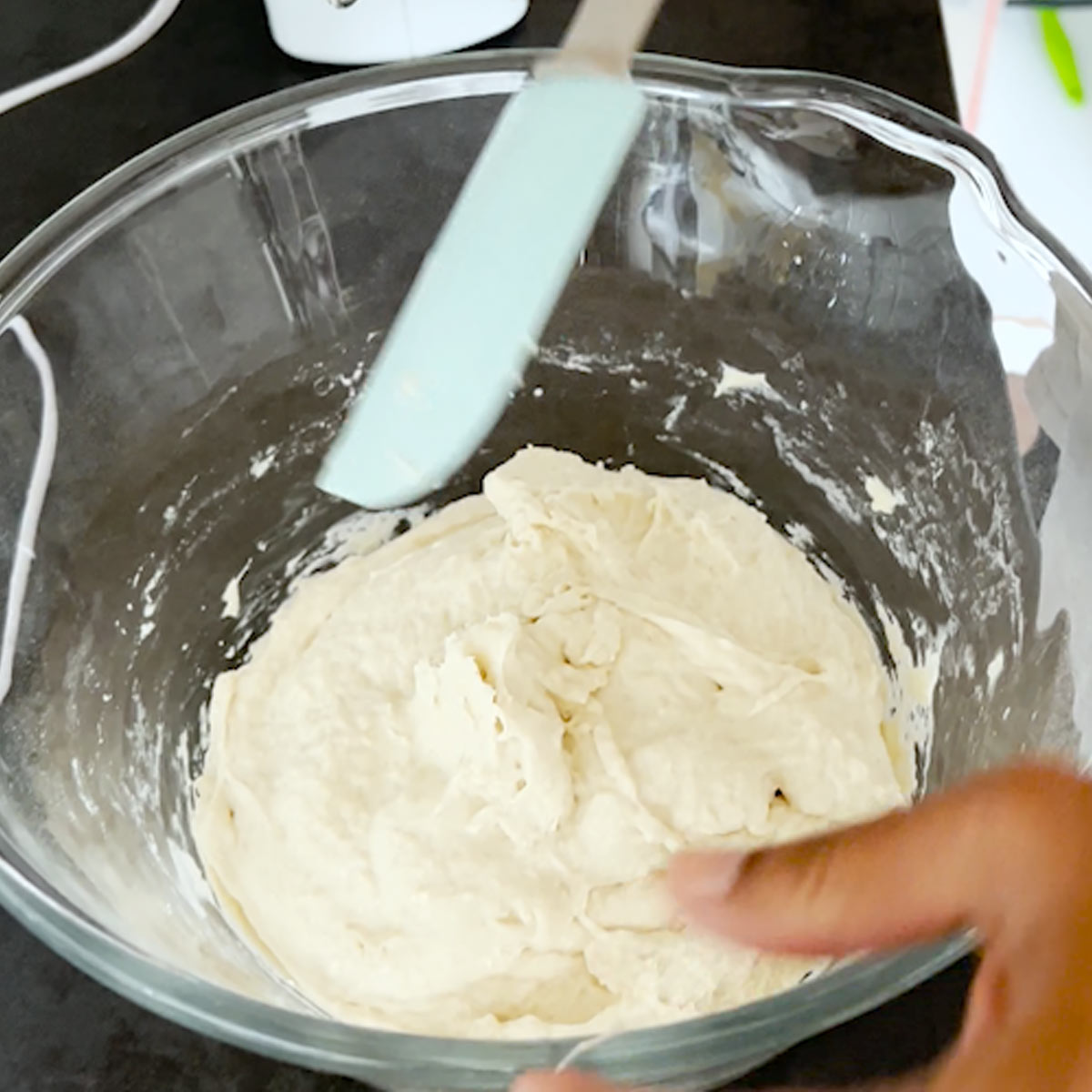

Step 4
After 2 ½ hours, remove the kitchen towel. Your dough will have risen!
Fold the dough with a silicone spatula. This strengthens the dough.
Cover again with the kitchen towel and leave to rest again so that it can rise further, for another 2 hours.
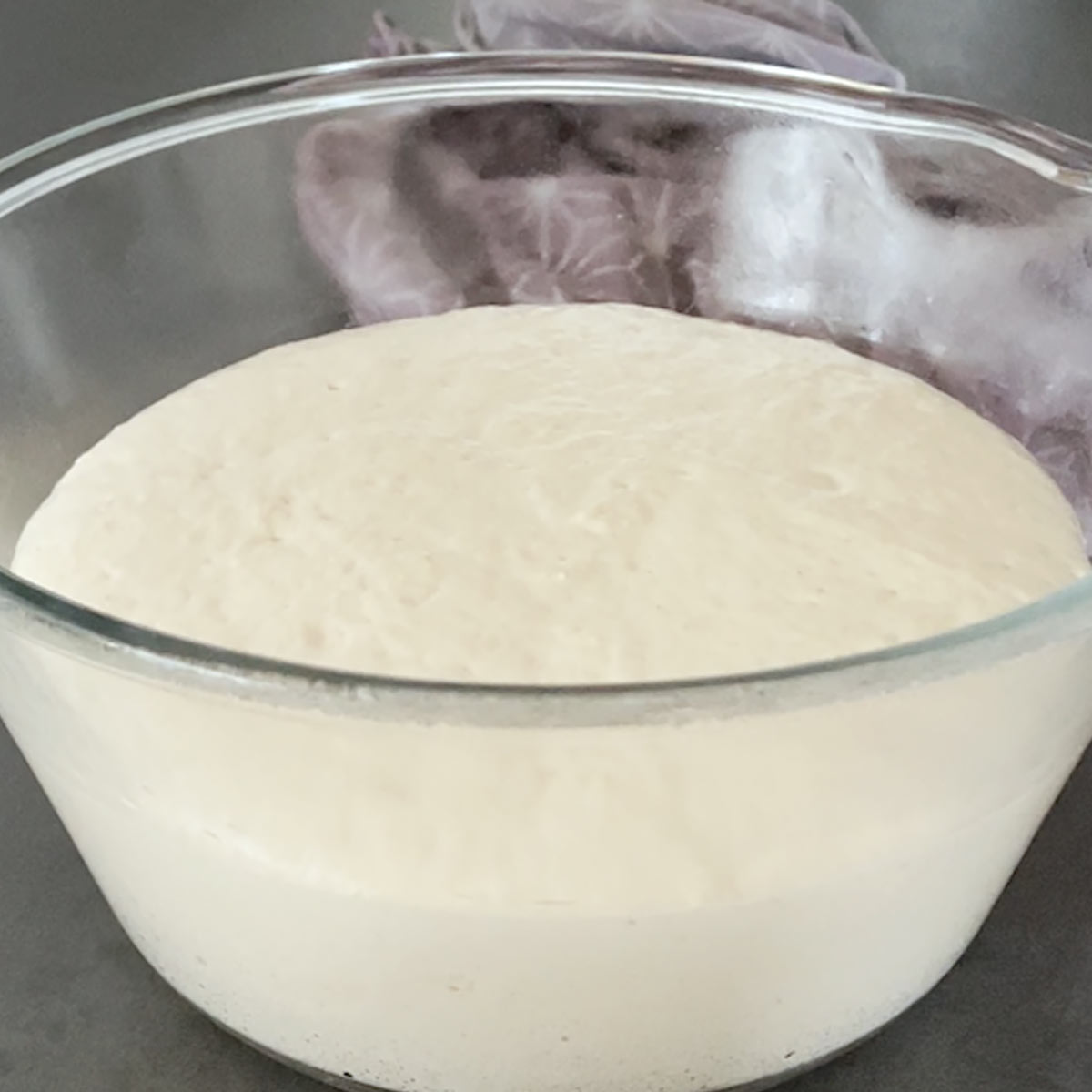
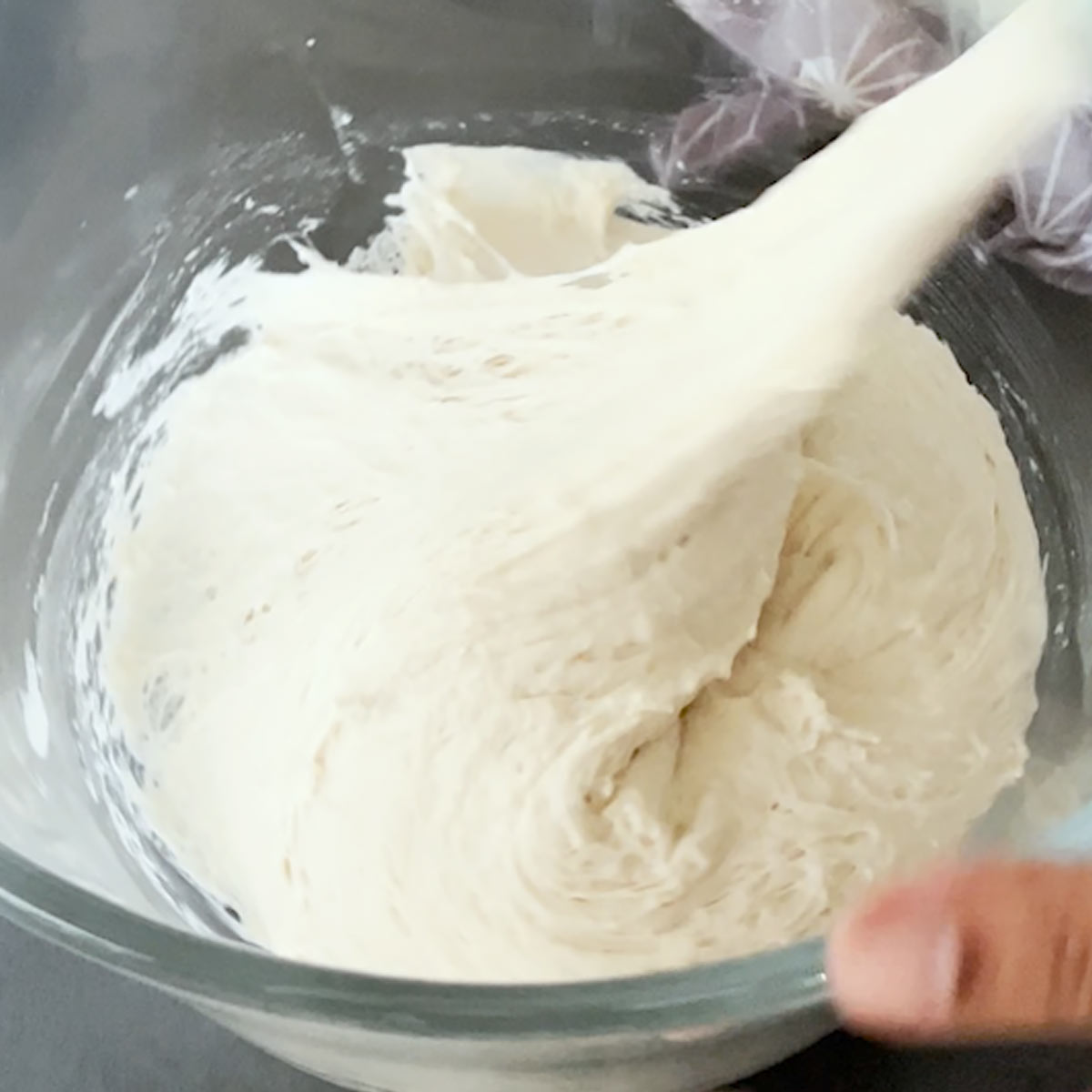
Step 5
After 2 hours of leaving the dough to rise, prepare your baguette pan. Sprinkle water on the pan and place parchment paper on that.
Fold your baguette dough a second and last time.
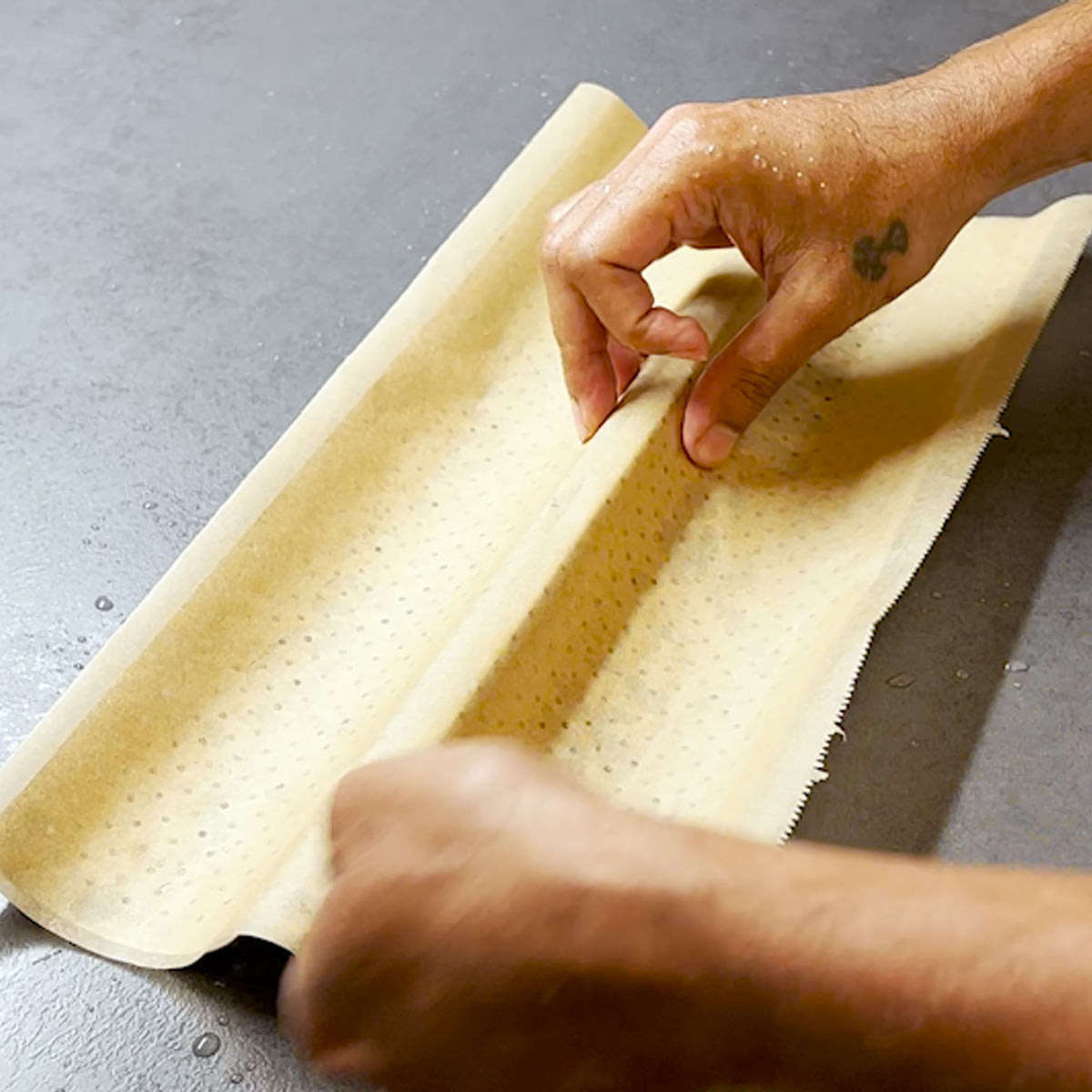
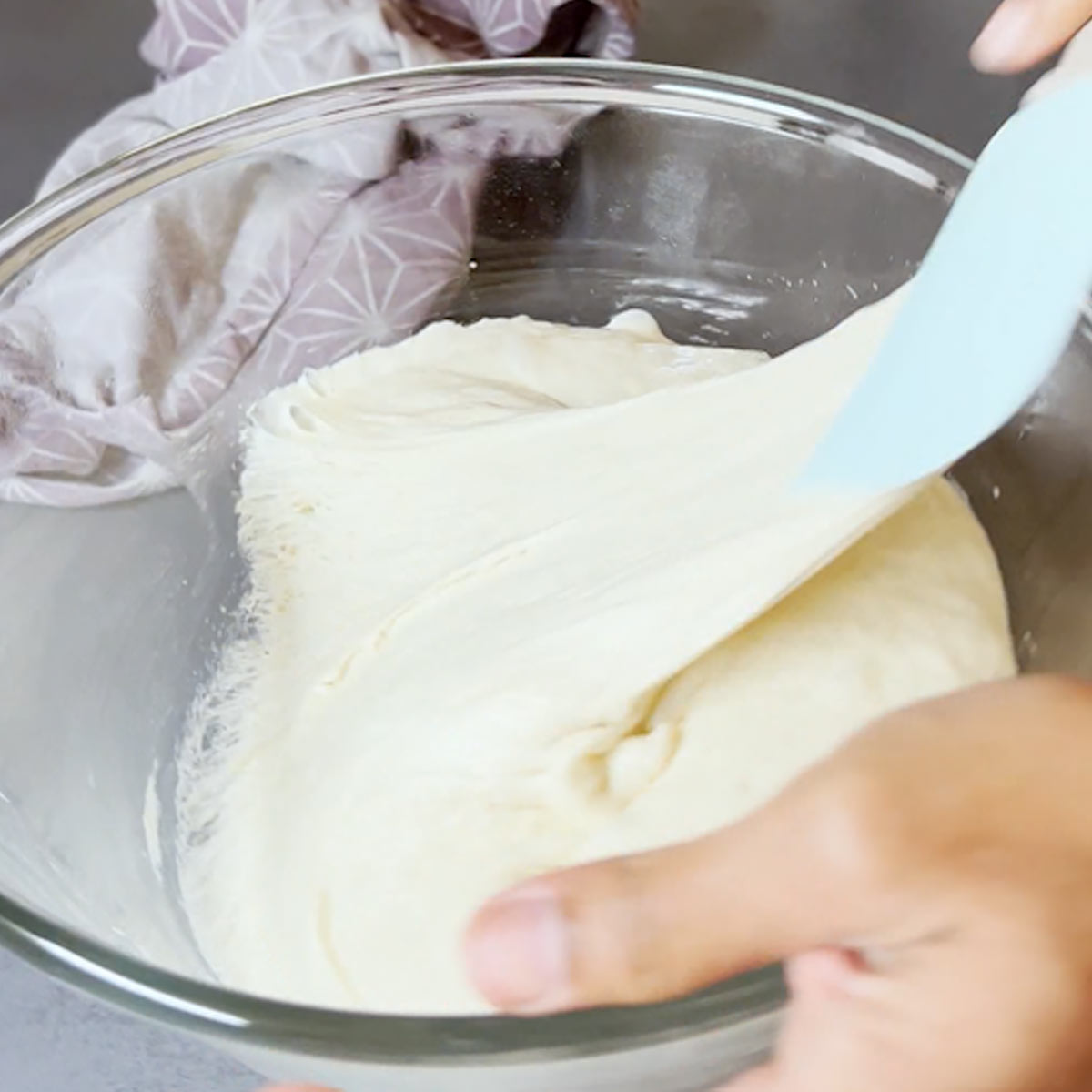
Step 6
Carefully pour a piece of dough into one of the baguette molds. Do that in batches.
Spread the dough with a silicone spatula because the dough is super sticky.
Shape it into two equal sized baguettes.
Leave them to rest for another 30 minutes.
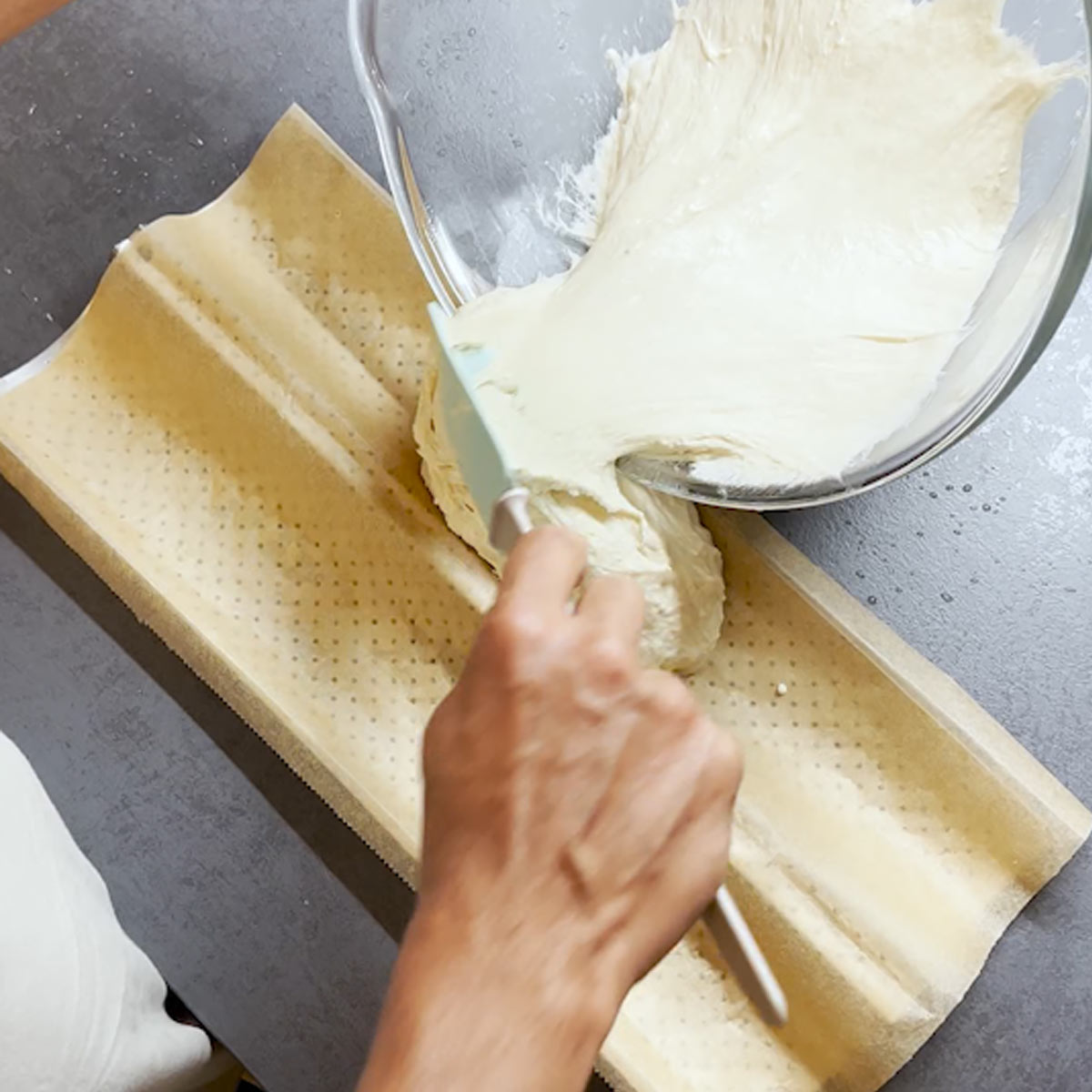
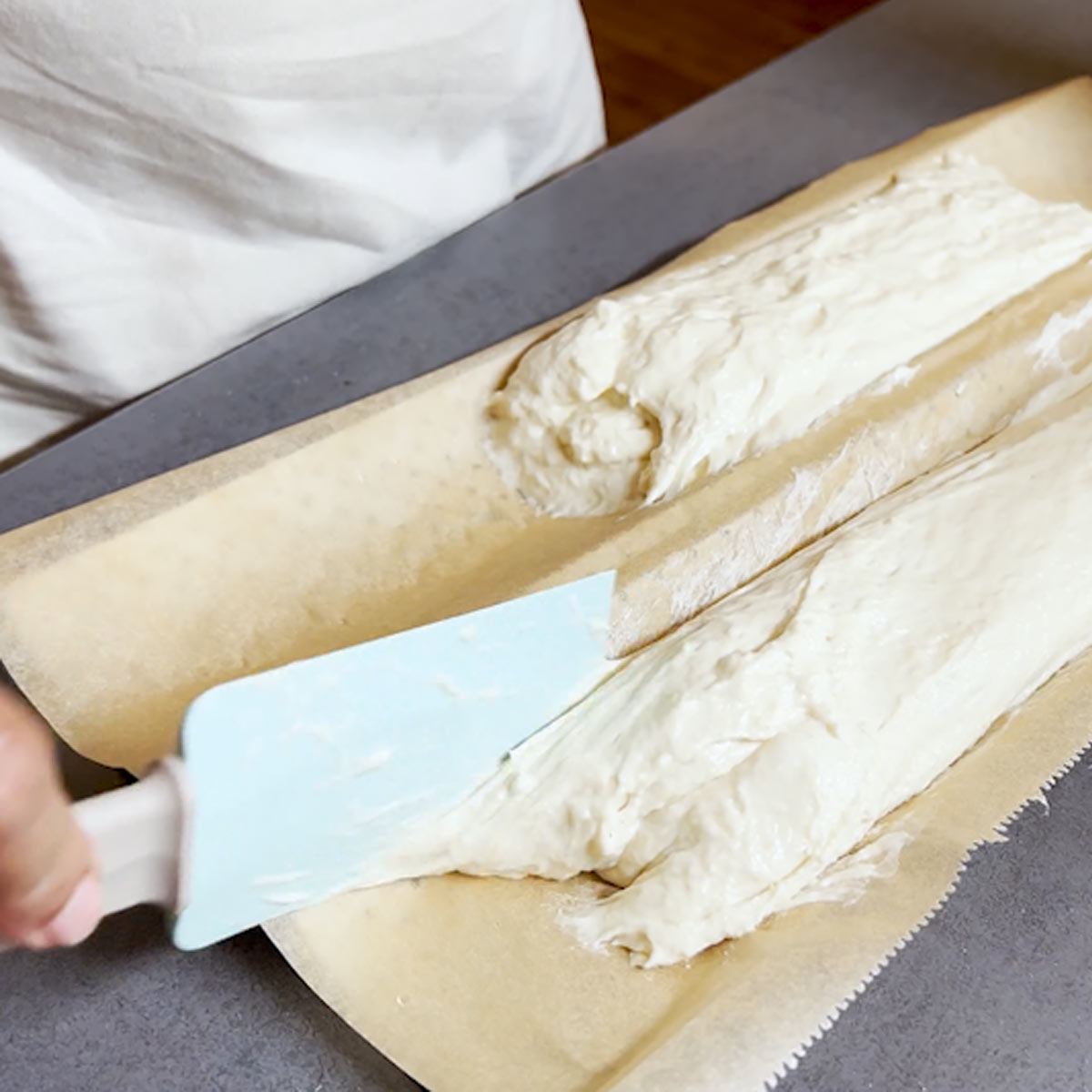
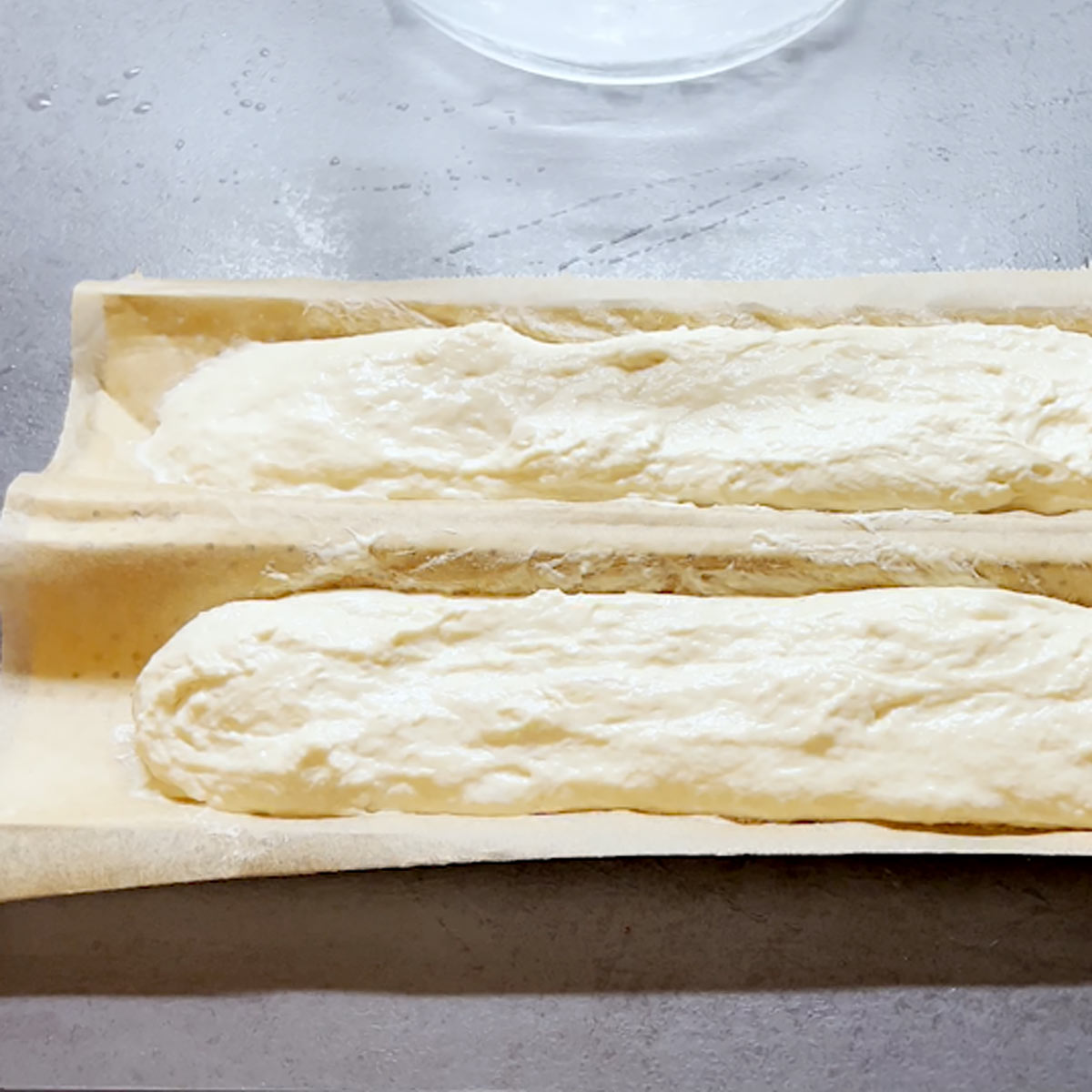
Step 7
Preheat your oven.
Dust your raw baguette with flour.
Score your baguette by cutting into the top with a sharp knife.
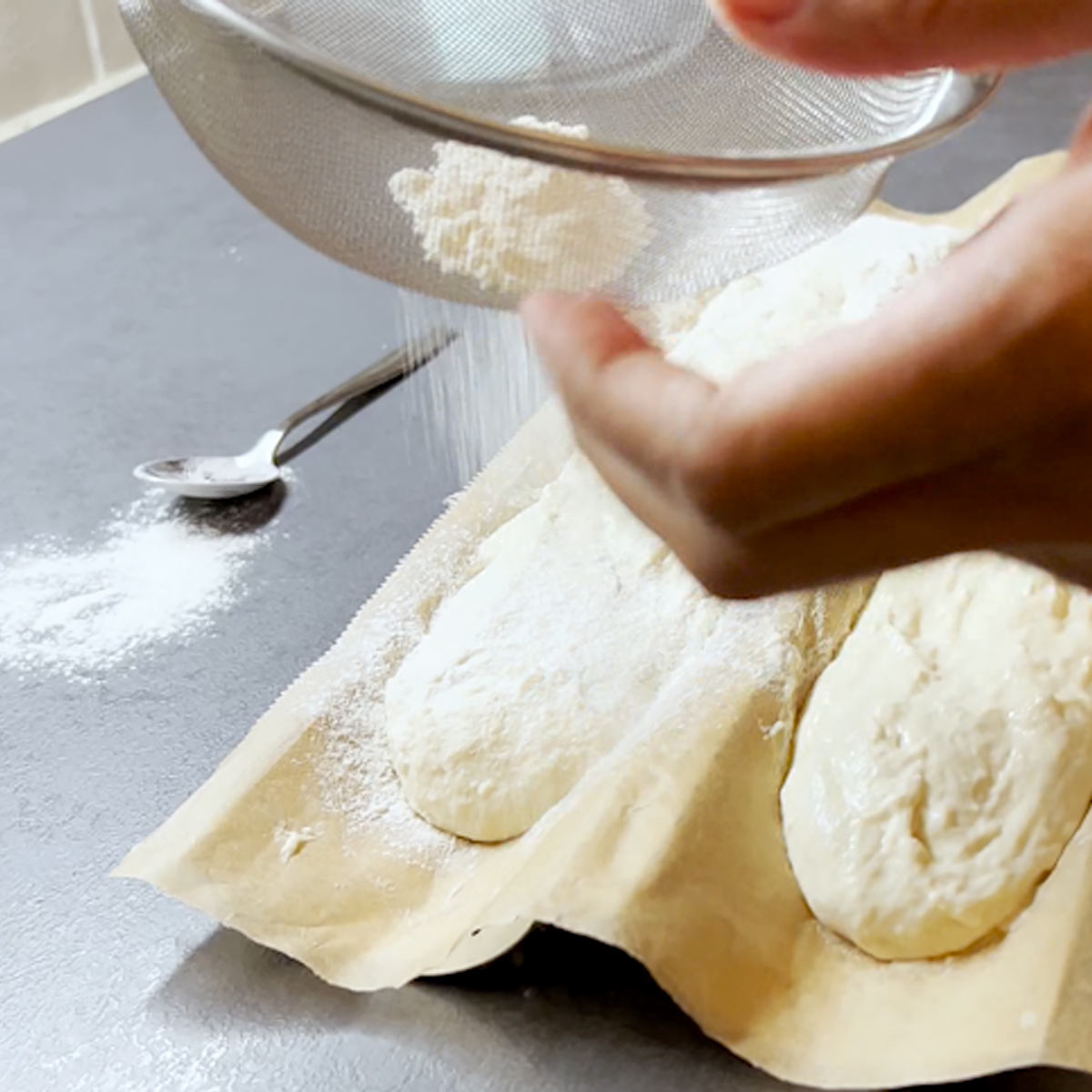
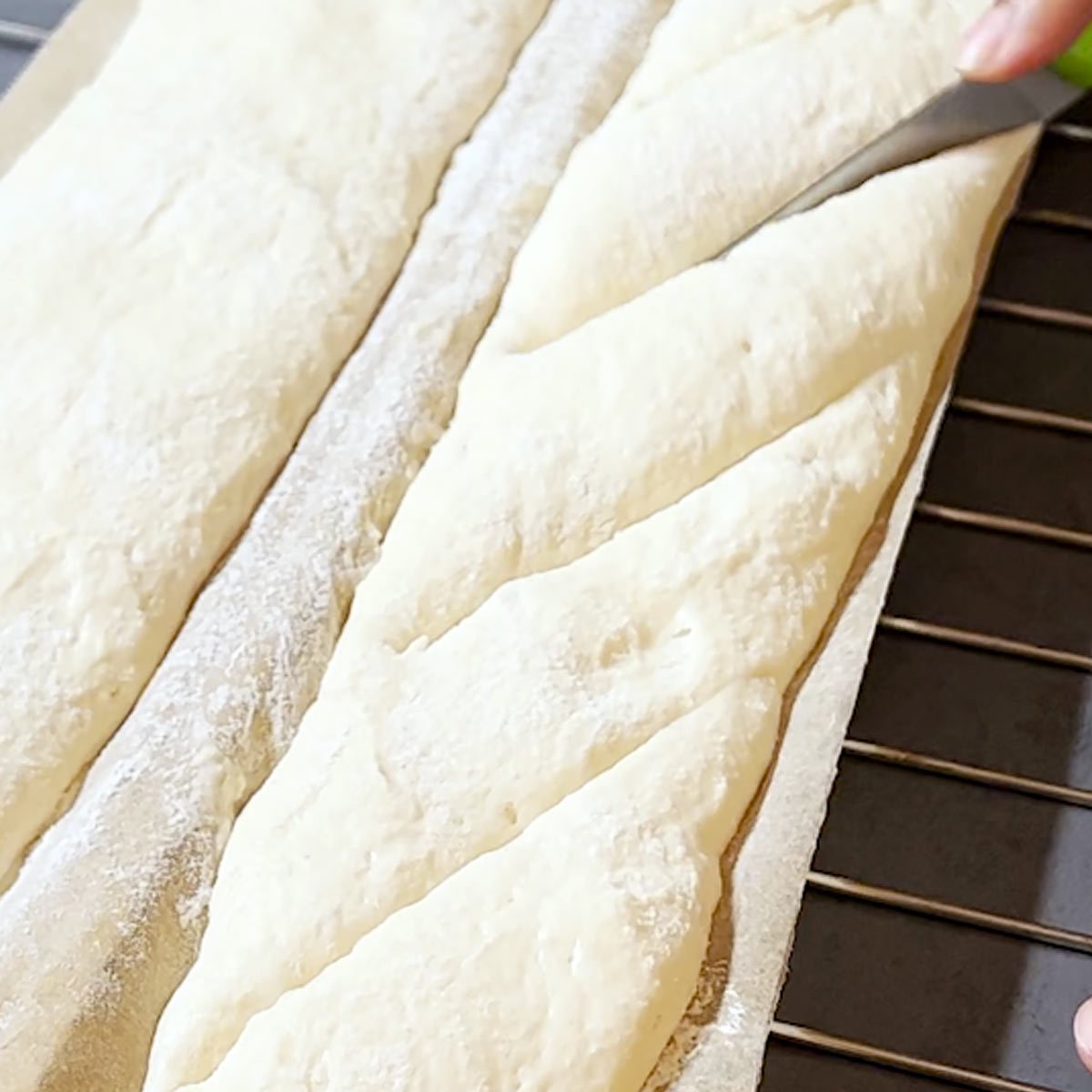
Step 8
Bake Baguette at a steady heat.
Take out from the oven when golden brown and leave to cool a bit.
Remove excess flour.
Enjoy your Baguette!
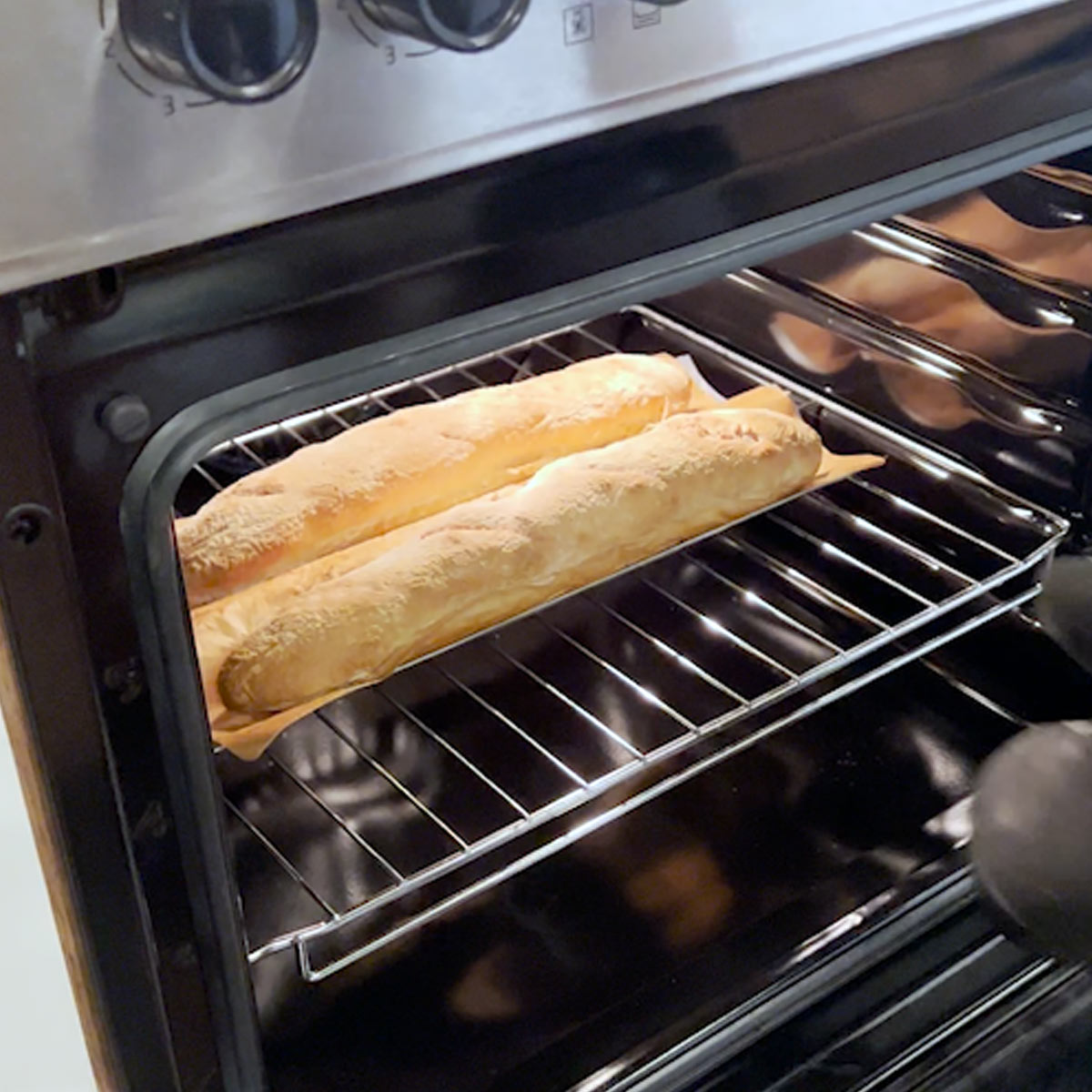

📜 Tips
Making and baking a baguette is truly science at its best! Every step can determine if your baguette will resemble a French baguette or if it's just meh.
Follow these useful tips to the T, to succeed baking your first french Baguette from scratch at home:
- Use the right flour. Pick a white flour such as pastry flour or 00 type flour because it's much lighter and will create the airy texture that we are looking for in a baguette.
- Paul likes to use fresh cake compressed yeast to make Baguette as it adds a more natural wholesome flavor to the baguette. Cake compressed yeast is also more common in Europe than in the US. That said, you are free to use dry active yeast, if that is what you have at home or get in stores. Just make sure it's not expired!
- Mix the yeast in lukewarm water to help it activate. The yeast will “awaken” faster.
- The dough needs to be kneaded well. This is important because the gluten in the flour will get activated that way and that in turn creates the elasticity of your baguette dough. When it is elastic, it will rise better since the yeast gets to feast through the carbs, and that creates those airy pockets in your bread. Use a kitchen machine or hand mixer with a dough hook.
- Your dough needs to be left in a bowl to rise. Cover the bowl with a damp clean kitchen towel and leave it to sit for the first rising cycle in a warm area at room temperature. Paul just keeps it out on the kitchen counter, I like to turn on the light in the oven and that little light creates a little warm environment, which helps the yeast to eat through the dough.
- After the first rising cycle, you will need to briefly fold in the dough, the purpose is to give the yeast a new dough area to eat through.
- Cut the baking sheet to the size of the baguette pan.
- Baguette pans keep your baguette in shape during the resting and baking period. The baguette pan needs to be lined with parchment paper. Sprinkle some water over the pan and place the parchment paper over that so that it hold better in the shape. Many pans come with an option of making 3 baguettes. You don't have to fill every baguette mold, one can be empty during the baking cycle.
- Scoring is when you make cuts at the top of your raw dough just before baking the bread. You do that so that the baguette gets to expand to its typical shape. It helps in releasing steam and making sure the baguette doesn't malform. But since this dough is so very sticky, it can get tricky to score. The solution is to keep a small very sharp knife in the freezer, and then score your dough with that. A razor blade is also an option, but we found it a bit tricky to hold it in the hand and single shaving blades are not always easily purchasable.
- Your baguette will develop a crunchy crust with steam in the oven. To achieve that, place a ramekin or baking tray with some water into the oven during the preheating cycle and keep it there at all times when you are baking your baguette. The heat of the oven will get the water to steam and that will result in a perfect crunchy baguette crust. Sorry, Paul forgot to show it in the video when we filmed this video, but he usually always does it.
- Don't open your oven while baking, that constant heat is required for the crust to form.
- The baguette is ready and done baking after about 20 minutes, baked at a constant temperature of 460 Fahrenheit (240 degree Celsius). The oven has to have preheated at the same temperature, and you can't open the oven while baking. You can see when it's done when the bread looks golden brown.
- Practice, practice, practice! Your baguette might not turn out flawless the first time, and that's ok. Baking a perfect baguette comes out of experience.
🍱 Storing
A baguette is a day bread that should be consumed within 24 hours. This is because, like any other white bread, it tends to get harder the longer it sits out.
So, the best time to consume your baguette is always right after baking.
This is also why people in France will always go out and buy a freshly baked, still warm baguette in the morning and evening. Bakers there typically bake twice a day to meet the demand.
If left out, the baguette will turn hard on the inside and the outer crust will just get soft. This is especially true in a humid wet tropical environment.
You can't really avoid all that, but you can keep your baguette in a bread box (cut it into two to make it fit) or even better in a linen bag.
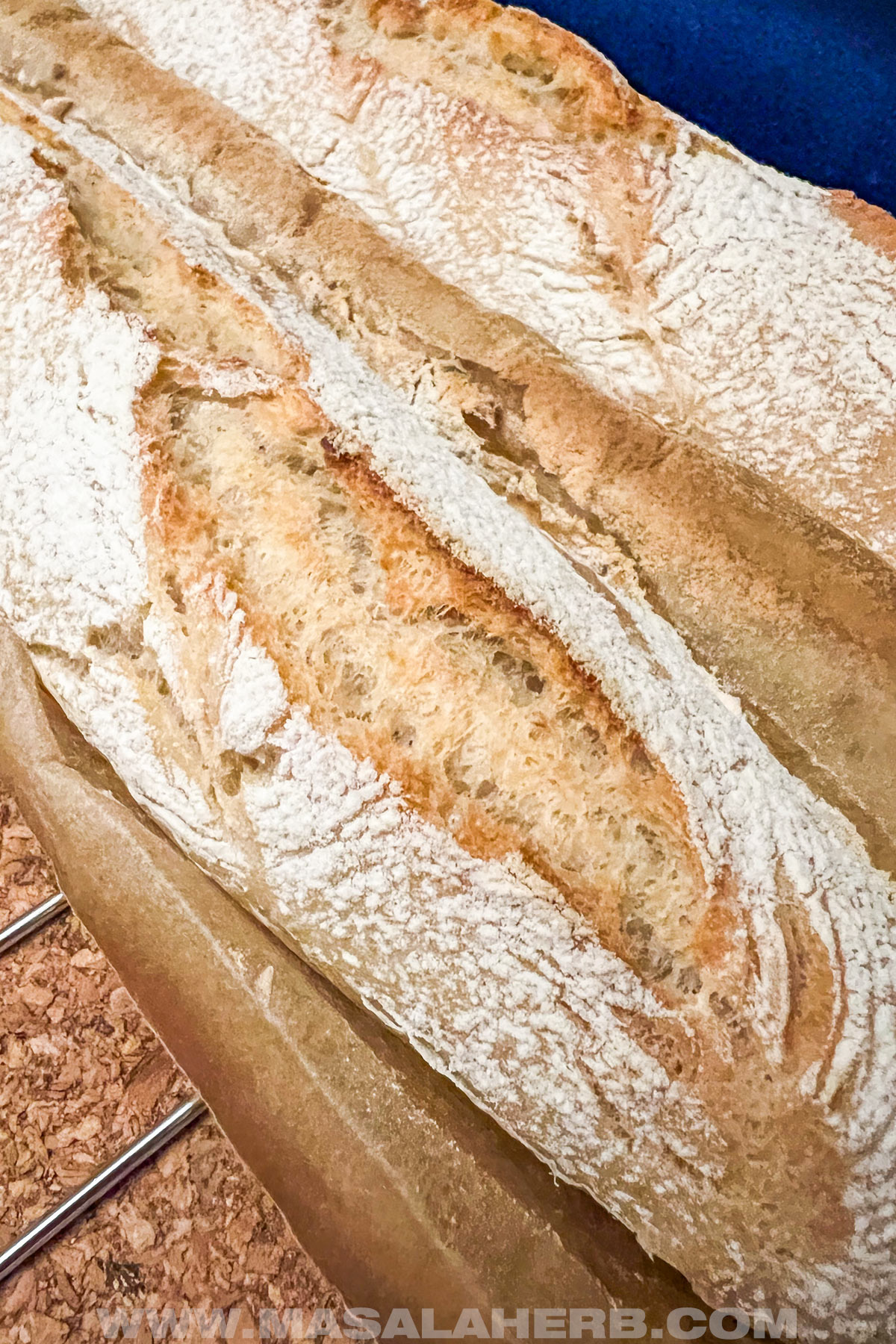
💡 Ideas to use your Baguette Bread
Baguette bread is a day to day bread in France. You have it for breakfast with butter and jam and for lunch and dinner with a home cooked meal and wine.
Make quick garlic bread and serve them up with your main course meals, or how about Bacon French Bread Pizza?
In my opinion, baguette bread is perfect in its most natural state with either jam or liver Pâté. Paul loves his homemade bread with cold cuts and cheese.
French jam are special because they only include the best of fruits and sugar, so they are free of artificial ingredients. I have plenty of french jam recipes that my family makes.
You can use the baguette too as a base for Italian Bruschetta or Crostini appetizers. I have used it to make vegan appetizers too.
Use the baguette to make lunch sandwiches or open-faced oven baked french pizza baguettes.
💭 FAQs
The dough has to rise, and you need to fold it as per our instructions. If you skip all that and try to cut the chase, your baguette won't rise during the baking process in the oven. Stick to the heat setting as described in the recipe and don't open the oven door during the baking process. Moreover, make sure to use quality yeast and check the expiry date.
Setting for regular ovens in the US: Pick the normal “bake” setting on your oven. Settings for ADVANCED ovens or ovens in Europe: If your oven has some more special options, choose the top bottom heat setting (not the broiler option, that's something else all together!). Otherwise, the bottom heat setting will work fine too (that's the regular “bake” setting on most ovens in the US). Don't use the fan convection setting, if you have that on your oven for baking any bread.
Use a high heat setting because you want to bake the baguette in a flash for the crust to form on the outside. Set it at 460 Fahrenheit (240 degree Celsius) all along, from preheating to baking.
You can use bread flour, but it won't turn out as airy as with pastry flour or all-purpose flour. I don't recommend substituting with whole wheat flour because this recipe is not made for heavier and less gluten-rich flours.
Yes, in most former french colonies you will find Baguette being sold commercially. It is still very popular bread in Morocco, Algeria, Burkino Faso, Canada, and Vietnam.
No, baguette can mean a rod or a stick, as in chopstick. The French word for bread is “pain”.
👁️ More Bread Recipes:


Global Food Recipes
with Spices and Herbs
Free E-Book available for a limited time. Grab yours now and get instantly inspired!
You missed out!
📖 Recipe
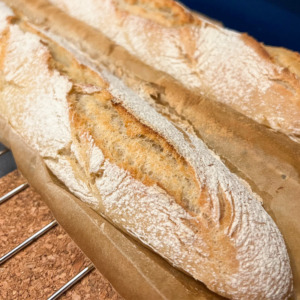
Paul's Baguette Recipe
Ingredients
To activate Yeast
- 1½ Teaspoon Instant Yeast *see Notes for fresh cake compressed yeast measurements
- ⅓ Cup Water lukewarm
For the Dough mixing
- 3 Cup All-purpose Flour *see Notes
- ½ Teaspoon Salt
- 1 Teaspoon Sugar
- 1 Teaspoon Olive Oil optional
- ¾ cup + 2 Tablespoon Water
- All-purpose Flour to dust
Instructions
Preparing the baguette dough
- Place your yeast (dry active or fresh) into a small bowl and pour in lukewarm water). Dissolve the yeast completely in the water. Keep aside1½ Teaspoon Instant Yeast, ⅓ Cup Water
- Take a large bowl and pour in the flour. Add to that the salt, sugar and olive oil. Pour into the flour also the yeast dissolved in water.3 Cup All-purpose Flour, ½ Teaspoon Salt, 1 Teaspoon Sugar, 1 Teaspoon Olive Oil
- Place your stand mixer or hand mixer dough hook into the flour and other ingredients in the bowl. Pour in all the water.¾ cup + 2 Tablespoon Water
- Turn on your machine and start mixing and kneading the dough. Knead the dough until you have a smooth elastic sticky batter. This can take about 5 minutes.
Dough rising and folding
- Scrape batter off the sides of your bowl to assemble it in the center of your mixing bowl.
- Wet a kitchen towel so that it's damp and wrap the kitchen towel around the bowl to cover it.
- Leave the dough to rest and rise for about 2½ hours at room temperature.
- After 2½ hours, remove the damp kitchen towel. Your dough should have risen considerably.
- Fold your sticky dough with a silicon kitchen spatula by turning around the bowl. The dough will lose its airiness, and it will fall back to its original size from earlier.
- Cover your dough in the bowl once again with the damp kitchen towel and leave to rest and rise for another 2 hours.
- After 2 hours, prepare your baguette pan. Cut your parchment paper to the size of your baguette pan. Sprinkle some water over the pan and place parchment paper into the pan. It will stick and take on the shape of the pan, thanks to the sprinkled water.
- Fold your dough for the second and last time.
Baguette pan
- Spread some sticky dough with the help of a silicon spatula in one of the molds. Do that in batches and add small dough quantities into the mold, a bit at a time.
- The dough can be spread with the motion of the silicone spatula dragging it into a direction. Make sure to shape it in at the borders too. (see video)
- Leave the shaped raw baguette dough to rise for another 30 minutes in the baguette pan. They will both gain a little shape and turn lighter.
- Preheat oven to 460 Fahrenheit (240 degree Celsius). Tip: Keep a ramekin or an oven safe bowl with water in your oven, which will create steam and help in the formation of the crust.
- Dust your baguettes with flour.All-purpose Flour
- Score in at the top of your baguette with a very sharp knife. Tip: Keep a knife in the freezer for 10 minutes. Scoring the sticky dough with the frozen knife will be much easier.
Baking and finishing
- Bake the baguette at 460 Fahrenheit (240 degree Celsius) for about 20 minutes. It may vary between 17 and 20 minutes, depending on your oven. The baguette is done when it turns golden brown.
- Take out your baguette and leave to cool.
- Once the loaves have cooled, remove excess flour.
- Enjoy your homemade baguette!
Notes
- Try to get and use pastry flour, it's much lighter and better suited for making baguette bread. Also, 00 or double zero flour is an option. If you have all-purpose flour at home, you can use that too, but Paul said that his baguette wouldn't turn out that light with all-purpose flour.
- You can choose between active dry yeast or fresh compressed yeast. Paul used a fresh yeast cube in the video because the bread turns out better, as fresh yeast tends to be a better quality yeast. But it's alright to use dry active yeast in this recipe too.
- Dry to fresh yeast conversion for 2 Baguette: 1½ Teaspoon dry active yeast equals 0.4 ounces fresh compressed cake yeast or about ⅔ of the compressed yeast cube. That's 12 grams fresh cake compressed yeast.
- We mix the yeast in the water to help it activate. It's also easier to spread it that way into the dough.
- Knead the dough well with the kitchen machine dough hook. The dough should be sticky, smooth, and elastic.
- The dough has to rise as per instruction or else it won't turn out airy. The dough rises, and then you have to fold it. You do that because the yeast needs to eat through a new batch of carbs in your dough. Their eating creates air pockets and that's why your dough is rising and getting all airy and fluffy.
- Cut the parchment paper into the shape and size of the baguette pan.
- Use a silicone spatula to spread out the dough in the baguette mold. You won't reach anywhere without this tool, so it's essential!
- Score your raw baguette with a sharp knife. An ice-cold knife can deal better with the sticky dough. Another option is a razor blade, but I, personally, found it to be a clumsy option and much preferred the cold knife.
- Preheat and bake with a bowl of water in a ramekin or an ovenproof bowl left in the oven. This will create steam in the oven and result in a crunchier bread crust.
- Remove excess flour from your bread at the end.
Equipment
- Stand Mixer or hand mixer with a dough hook
- Large bowl
- Damp Kitchen Towel
- Baguette pan for two loaves, 15×6.3 inches or 38×16 centimeters
- Parchment Paper cut it to the size of the pan
- Pairing knife or razor blade sharp

Comments
No Comments